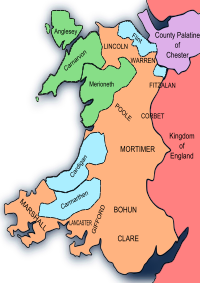Lordship of Denbigh

The Lordship of Denbigh was a
The crown disposed of much of the lordship's lands over the following centuries. Although the lordship still technically exists, with the monarch as its holder, its remaining lands, chiefly
Origins
Prior to the creation of the lordship of Denbigh in 1284, the territory of the lordship was part of the Principality of Gwynedd. Since the Norman invasion in the 11th century, Wales had been divided between the native Welsh principalities and lordships in the north and centre of the country, and the Marcher lordships of Anglo-Norman origin in the south and south-east.
The Marcher lords exercised effectively independent power in their territories and had only a nominal feudal allegiance to the king of England. During the 13th century, the Welsh princes of Gwynedd, taking the title Prince of Wales, had built up their power to such an extent that the English king, Edward I, launched a war of conquest of north Wales between 1277 and 1283.
Following the final defeat of the last Prince of Wales,
History
Marcher lordship
As a marcher lordship, the lordship of Denbigh was not a part of the
Following the grant of the lordship to him, the Earl of Lincoln founded the borough of
The Earl of Lincoln died in 1311, leaving his daughter,
From the
Merger with the Crown and revival
Although it became merged with the crown in 1461, it retained its identity as a Lordship outside of the Kingdom of England until, as with the rest of Wales, it was effectively incorporated into the kingdom by the
In 1563,
in as large and ample a manner...as was used when it was a lordship marcher with as large wardes as council [sic] learned could devise.[9]
Although the Laws in Wales Acts had not been modified – and the claim to have the same rights as a Marcher Lordship could not therefore be legally possible – Leicester had such political power that he could make this a reality in practice.[9] Leicester's administration of the lordship aroused violent hostility from the residents. After putting down a "rebellion" of the townspeople of Denbigh, Leicester sought to reconcile them by building the first Town Hall together with a Market Hall, and began the construction of a chapel.[10]
In 1585, Leicester mortgaged the lordship to a group of London merchants for £15,000.[11] On his death, with the debt unpaid, the Queen redeemed the mortgage and the Lordship returned to the crown in 1592/3.[11]
In 1696,[12] William III briefly made a grant of the lordship of Denbigh, to the Earl of Portland.[6] The inhabitants of Denbigh objected to this so strongly that they petitioned Parliament and had the grant rescinded.[6]
Over time, the crown sold off much of the original territory of the lordship, particularly during the reign of Charles I and, also during the Commonwealth period.[13]
Modern vestiges of the lordship

The lordship of Denbigh remains in existence, with the monarch as its Lord of the Manor.
Additionally, there is a Lordship of Denbigh "Estray Court".
In Denbigh The Crown Estate supports an annual Estray Court. Once a year, usually a Saturday in July, an Estray Court convenes allowing commoners the opportunity to claim their lost sheep. Successful claims entail the payment of a nominal "fine", imposed by the Court, which then sanctions the return of the sheep. Animals which are not claimed, or in respect of which claims are rejected, are auctioned by way of conclusion to the proceedings.[15]
When the last of the
Lords of Denbigh
- Henry de Lacy, 3rd Earl of Lincoln, 1284–1311
- Alice de Lacy
- Hugh le Despenser, 1st Earl of Winchester, 1322–1326
- Roger Mortimer, 1st Earl of March, 1327–1330
- William Montagu, 1st Earl of Salisbury, 1331–1344
- William Montagu, 2nd Earl of Salisbury, 1344–1354
- Roger Mortimer, 2nd Earl of March, 1354–1360
- Edmund Mortimer, 3rd Earl of March, 1360–1381
- Roger Mortimer, 4th Earl of March, 1381–1398
- Edmund Mortimer, 5th Earl of March, 1398–1425
- Richard of York, 3rd Duke of York, 1425–1460
- Edward of York, 4th Duke of York, later Edward IV 1460–1461
- merged with the crown following Edward IV's accession 1461–1563
- Robert Dudley, 1st Earl of Leicester, 1563–1588
- reverted to the crown, 1588/1592-1696
- William Bentinck, 1st Earl of Portland, 1696
- reverted to the crown, from 1696
References
- ISBN 978-0-7083-1076-2. Retrieved 3 July 2012.
- ^ a b Thomas Jones Pierce (1959). "LACY (DE), of Halton". Dictionary of Welsh Biography. National Library of Wales. Retrieved 6 July 2012.
- ISBN 978-0-7083-1076-2. Retrieved 3 July 2012.
- ^ ISBN 978-0719053252. Retrieved 7 July 2012.
- ^ ISBN 9781843831167. Retrieved 6 June 2012.
- ^ a b c d e f Lewis, Samuel (1849). 'Denbigh – Denbighshire', A Topographical Dictionary of Wales. pp. 288–304. Retrieved 6 July 2012.
- ^ ISBN 9781903153062. Retrieved 7 July 2012.
- ISBN 978-0710204912. Retrieved 7 July 2012.
- ^ ISBN 978-0719053252. Retrieved 7 July 2012.
- ^ "The History of Denbigh". Information Britain. Retrieved 14 July 2012.
- ^ ISBN 978-0719053252. Retrieved 7 July 2012.
- ^ Williams, John (1836). Ancient & modern Denbigh: a descriptive history of the castle, borough . p. 257. Retrieved 7 July 2012.
- ^ Sir Owen Morgan Edwards (1896). "The Lordship of Denbigh in 1649–50". Wales: A National Magazine for the English Speaking Parts of Wales. 3: 34. Retrieved 14 July 2012.
- ^ a b c "Statement by the Lord Chancellor in Parliament". Parliamentary Debates (Hansard). 2 May 1977. Retrieved 9 July 2012.
- ^ National Assembly of Wales. 2011. Retrieved 9 July 2012.
- ^ "An Environmental Strategy and Action Plan for the Hiraethog Area, p.7" (PDF). Conwy County Borough Council. 2002. Archived from the original (PDF) on 4 March 2016. Retrieved 9 July 2012.
- ^ "section 23(1)(a)(i), Administration of Justice Act, 1977". National Archives. Retrieved 9 July 2012.
